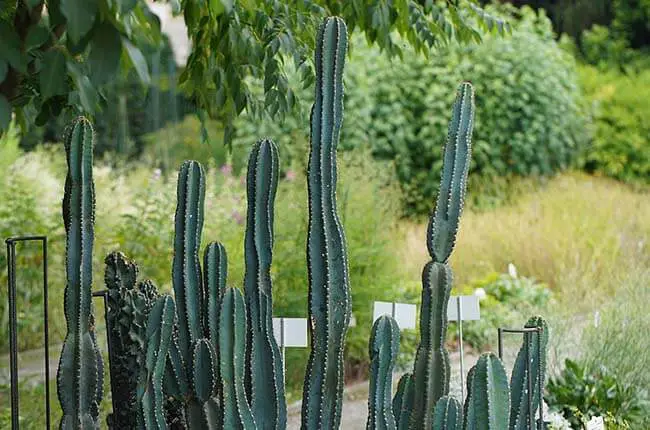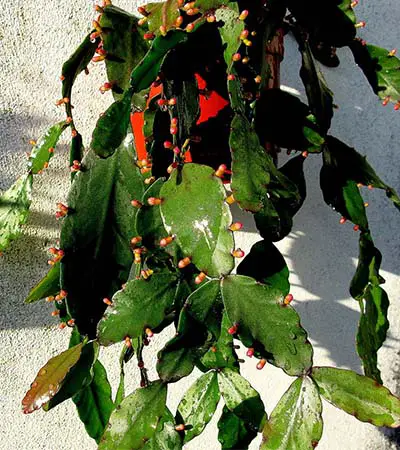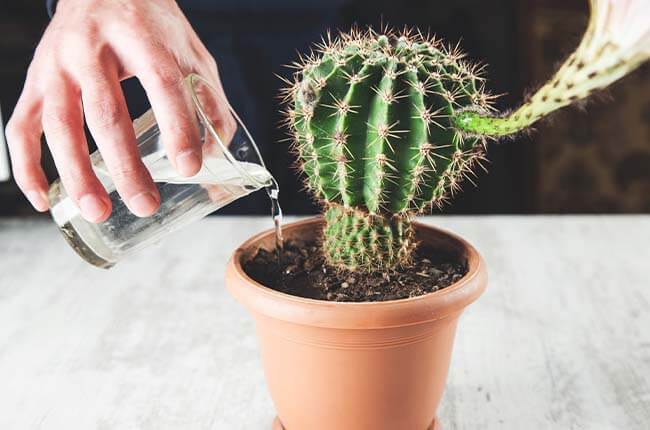When it comes to cacti, many people might assume that these drought-tolerant plants thrive only in arid environments with low humidity.
However, some cactus species actually prefer higher levels of humidity. So, it depends on the species of the cactus.
Generally, epiphytic cacti like high humidity levels of 50-80%, and dessert-dwelling cacti species with thick columnar stems and spines prefer low humidity levels of 10-30% without developing fungal issues.
Understanding the specific humidity preferences of different cactus species is key to providing the best possible care for these prickly companions.
Let’s get started.
Low-humidity cactus species
Cacti that are native to desert or semi-arid regions prefer extremely low humidity conditions levels of between 10 – 30%.
These types of cacti have adapted to store water in their stems and leaves, enabling them to cope with long periods of drought. They can be columnar types of cacti with thick stems to store water and can also feature thin leaves that look like sharp spines or hair to conserve water.
Here are some examples of such drought-tolerant species that prefer low-humidity conditions:
- The Saguaro Cactus (Carnegiea gigantea) is an iconic cactus species native to the Sonoran Desert. Its thick stem can reach up to 2 feet (60 cm) in diameter, and it possesses sharp, curved spines. The Saguaro thrives in low-humidity environments, typically preferring humidity levels between 10-30%.
- The Golden Barrel Cactus (Echinocactus grusonii) features a thick stem that can grow up to 3 feet (90 cm) in diameter. It has long and robust spines, and it flourishes in arid conditions with humidity levels around 10-30%.
- The Totem Pole Cactus (Lophocereus schottii f. monstrosus) has thick stems that can measure 4-6 inches (10-15 cm) in diameter. While it is mostly spineless, it does have some small, rudimentary spines. The Totem Pole Cactus is well-suited to arid conditions, thriving in humidity levels between 10-30%.
- The Peruvian Apple Cactus (Cereus repandus) has a thick, columnar stem that can grow up to 10-20 inches (25-50 cm) in diameter. The cactus is covered in sharp, numerous spines and thrives in humidity levels ranging from 10-30%.
- The Old Man Cactus (Cephalocereus senilis) is a distinctive hairy cactus species that also favors low-humidity environments. Its stem is 4-6 inches (10-15 cm) in diameter, and the cactus is characterized by its long, white hair-like spines. The Old Man Cactus prefers humidity levels between 10-30%, making it well-adapted to arid and semi-arid conditions.

(AfroBrazilian, CC BY-SA 4.0, via Wikimedia Commons)
High-humidity cactus species
Cactus species that can tolerate high humidity are mostly epiphytic cacti that generally have thin, flat stems instead of thick succulent stems.
Epiphytic cacti grow on trees or rocks in tropical rainforests, rather than in the ground like their desert counterparts. They typically prefer higher humidity levels than desert cacti, often thriving in environments with humidity levels around 50-80%.
These cacti are well-adapted to their humid environment and require more moisture than desert cacti, making them suitable for indoor cultivation in more temperate climates.
In areas with high humidity levels, opting for these cactus types will ensure their healthy growth and adaptability.
Here are some cacti species suitable for high-humidity environments:
- Rhipsalis: Also known as “Mistletoe cactus”, Rhipsalis is an epiphytic cactus native to rainforests. It prefers high humidity and can be grown indoors or outdoors in partially shaded areas. It features thin and long trailing stems, making it perfect for hanging baskets.
- Schlumbergera: Schlumbergera is a small genus of 6 to 9 species commonly known as “Christmas cactus”, “Crab cactus”, “Holiday cactus”, Thanksgiving cactus”. They are native to the cloud forests of Brazil and thrive in shaded areas with high humidity. Their stems are thin and flat like leaves joined one to the other.
- Epiphyllum: Often called “Orchid Cactus”, Epiphyllum is another epiphytic cactus species with large, showy flowers. It prefers a humid environment and partial shade, making it an ideal choice for humid climates. It has flat, non-spiny and trailing stems.
- Hylocereus: The “Dragon Fruit” plant, Hylocereus, is native to Central and South American rainforests. It grows best in high humidity, but requires good air circulation to prevent fungal infections. The stems are long and thin with a triangular shape.

Signs of humidity issues
Too Low Humidity
When cacti are exposed to low humidity levels, they may exhibit the following signs:
- Wilting or shriveling: Although cacti store water in their tissues, excessively low humidity can cause them to lose water and appear wilted or shriveled.
- Brown spots or patches: These can indicate that the plant is struggling to retain moisture, leading to cell damage.
- Slow growth or no growth: Insufficient humidity can cause cacti to pause their growth or lead to stunted development.
Too High Humidity
On the other hand, when humidity levels are too high, cacti may display these symptoms:
- Soft or mushy leaves: Overly humid conditions can cause cacti cells to absorb too much water, leading to swollen and softened stems or leaves.
- Root rot: Excess moisture combined with high humidity can cause the roots to rot, inhibiting the plant’s ability to absorb water and nutrients.
- Fungal infections: Damp environments can promote the growth of fungus, causing disease or encouraging pests.
Monitoring the humidity around your cactus and adjusting it as necessary will help maintain a healthy environment for your plant to thrive.
Do cacti like to be misted?
Misting would not make much difference to a cactus because it can only cause a temporary rise in humidity for maybe a few minutes.
But growing drought-tolerant cactus species in a constantly humid environment or climate can result in fungal problems and root rot because their soil cannot dry out quickly. In general, this type of cactus thrives in environments with low humidity under 50 percent.
Just as with air humidity, drought-tolerant cactus species prefer soil that is not overly moist.
It is crucial to water cacti properly to maintain appropriate soil moisture levels. Water the cacti using a method that provides a sufficient amount of water without causing excessive moisture.
In summary, cacti do not generally require misting, as many of them thrive in low-humidity environments.
How to control humidity?
Adjusting Air Humidity
To achieve the ideal air humidity for your cactus, consider the following strategies:
- Improve ventilation: Ensuring good air circulation can help reduce humidity levels. Place your cactus near a window or use a fan to increase airflow.
- Utilize a dehumidifier: If you’re experiencing high air humidity levels, a dehumidifier can be a useful tool to lower moisture in the air around your cactus.
- Limiting water sources: Keep cacti away from water features, such as aquariums or humidifiers, which can add moisture to the air.
Adjusting Soil Humidity
Proper draining and monitoring of soil moisture can prevent overwatering, which can lead to root rot and other issues in cacti. Here are some ways to maintain optimal soil humidity for your cactus plant:
- Choose the right soil mix: A well-draining soil mix, consisting of sand, perlite, or other similar materials, will help to maintain optimal moisture levels in the soil.
- Watering schedule: Overwatering is a common issue when caring for cacti. Water your cactus sparingly and ensure the soil is completely dry before the next watering session.
- Proper pot drainage: Pots with drainage holes can help excess water escape, preventing soggy soil and reducing soil humidity.
- Use a soil moisture meter to monitor the moisture in the soil and to water only when the soil is completely dry.
Caring for cacti in humidity
Ideal Temperatures and Air Circulation
Most cactus species prefer temperatures between 65 – 85 Fahrenheit (18 – 29 Celcius) during the day and between 45 – 65 Fahrenheit (7 – 18 Celcius) at night. To maintain healthy growth, make sure to provide proper air circulation around the plant, as stagnant air can cause mold and other diseases to form.
Water Requirements
In general, cacti prefer a thorough soaking followed by a period of drying out. The frequency of watering depends on the cactus species, the size of the container, and various environmental factors.
- Indoor cacti typically require watering every 3 to 5 weeks during the growing season (spring and summer).
- Outdoor cacti should be watered only when the soil is completely dry, which may range from weekly to monthly depending on weather conditions.
Soil Preferences
Soil humidity is a crucial factor in cactus cultivation. Cacti prefer well-draining soil with low humidity to prevent root rot and bacterial or fungal infections. A suitable cactus potting mix often consists of:
- 50% inorganic material (such as perlite or pumice)
- 25% organic material (such as peat moss or coconut coir)
- 25% builder’s sand or fine gravel
Conclusion
In summary, cacti are plants that prefer arid conditions but can tolerate some levels of humidity, especially the epiphytic cacti. The key is to maintain a balance that meets the cactus species’ specific needs to ensure their healthy growth.
It is critical to strike a balance between providing sufficient moisture and preventing waterlogging, as excess moisture can lead to root rot and other issues for cacti. Factors such as temperature, growing medium, and airflow all play a part in determining the appropriate level of humidity for a given cactus type.
The use of a soil moisture meter can help cactus owners to take appropriate measures.
Happy gardening!
Related
20 Epiphytic Cactus (For Humid Weather)
Why Bottom Watering is (Actually) Better for Succulents
Top 10 Moisture Meters For Houseplants & Garden
- Keiki Paste vs Rooting Hormone:What’s the difference? - February 4, 2024
- Top 10 Orchid Fertilizers: A Comprehensive Review (2024) - February 2, 2024
- Top 8 Soil Inoculants For Stronger Plants (2024) - February 1, 2024


